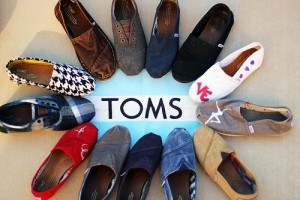TOMS: Evolving as a winner

TOMS – evolving its business model while remaining a winner
TOMS: Evolving as a winner
Company overview
TOMS was founded in 2006 by Blake Mycoskie after he traveled to Argentina and realized how many kids were barefoot, and not out of preference (1). Primarily a shoe retailer, TOMS is known for its “one for one model” – for every item purchased, something is given to someone in need. In recent years, TOMS has expanded into other segments that fit with its one for model, such as eyewear and bags. (2)
Business model
TOMS value creation is twofold – it creates value to consumers who want to purchase comfortable, stylish shoes, and to those on the receiving end of its donations through one of its 100+ shoe giving partners (3). Both of these are critical to how TOMS captures values from its customers. Could TOMS exist solely as a typical shoe retailer, without the social impact component? Potentially yes, but it would not be nearly as successful. Its shoes are not differentiated enough to capture enough value on their own. The pitch to customers that purchasing a TOMS pair of shoes helps someone in need is the big differentiating factor.
TOMS’s business model has evolved over time. Early on, the company was criticized for its band aid approach of providing a temporary solution (shoes) to address an underlying problem of poverty that is causing a need for shoes, a common criticism for one for one business models (4, 5). To address this criticism, TOMS changed to not only be about donating a physical product when it sells one of its products, but also be about helping to address the root causes in the areas it supports.
Operating model and alignment with business model
TOMS’s operating model has evolved accordingly with its business model. In its early stages, TOMS produced many of its shoes that it donated in China and India, but donated them to other countries (6). This aligned well with its original business model of donating shoes to those in need. As the business model shifted to address the underlying issue of poverty in these countries, the operating model shifted as well. TOMS has recently committed to manufacturing some of its shoes given out in local countries to help make an impact on the local economy by providing jobs (6). For its eyewear products, TOM is making a similar type of impact by providing eye exams and necessary treatments to help at the problems rather than just providing eyewear to those in need (3).
Conclusion: TOMS is a winner
The clear alignment of TOMS’ business and operating models has allowed it to respond to criticism about its one for one model in way that has satisfied critics to date (7). While this alignment is important for all companies, it becomes even more important for companies that include social impact as part of its business model. Companies claiming to value social impact need to back up their goals with actions that clearly support their goals, and TOMS does just that.
Sources
- http://www.entrepreneur.com/article/220350
- http://www.toms.com/
- http://www.toms.com/what-we-give
- http://boss.blogs.nytimes.com/2013/03/19/questioning-the-toms-shoes-model-for-social-enterprise/
- http://knowledge.wharton.upenn.edu/article/one-one-business-model-social-impact-avoiding-unintended-consequences/
- http://www.toms.com/stories/giving/reaching-milestones-in-local-manufacturing
- http://www.tinyspark.org/blog/critics/




Thanks for your post. One challenge I see for TOMS moving forward is how do they move away from being a one product fashion trend to a stable brand in a competitive industry. I also wonder if they will be able to continue solely banking on their philanthropic mission in marketing their product to consumers. As you mention they are now moving on from shoes to other fashion accessories, and I wonder if they can still maintain their margins if they add on traditional marketing levers to their promotional strategy.
Very interesting post! It was interesting to learn that TOMS is shifting its business model to also focus on helping to address the root cause of poverty in the countries it supports. It is clear to me how they are updating their operating model to align with this new business model through eye exams and creating jobs for local workers, however, I am curious how this shift also affects its other set of consumers – the buyers of the shoes and eyewear. It seems that the shift in the business model and subsequently its operating model requires significantly more capital and resources and the resulting value created for those on the receiving end is clear, but where is the company now capturing the additional value created? Ultimately, it seems that TOMS is providing additional value to its customer base but I wonder where, or even if, TOMS is capturing value to support itself. Are they charging buyers more for the products? Or are they not concerned about the additional value capture because of their social impact motives?